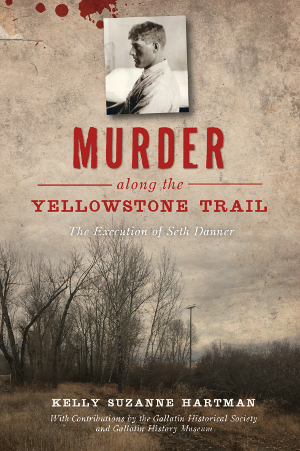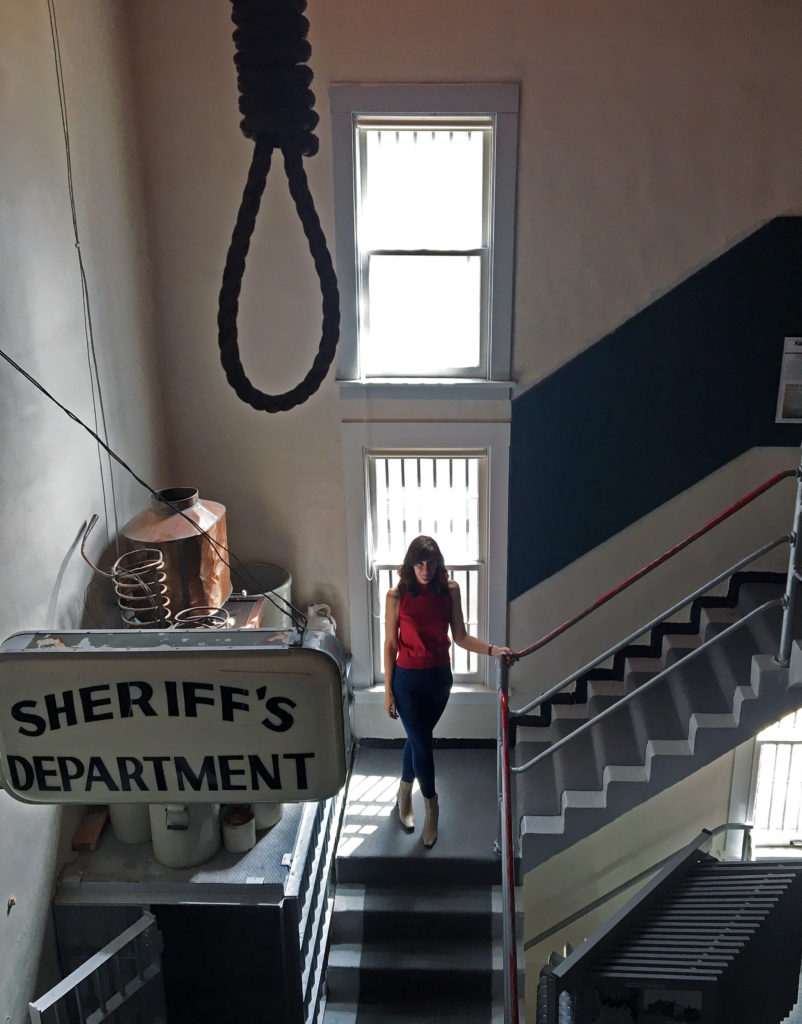
Having chased gangsters across the desert with historian Parker Anderson, we’re thrilled to sit down with author, curator, and artist Kelly Hartman, whose new book Murder along the Yellowstone Trail: The Execution of Seth Danner has just been published. Delving deep into the story of alleged Montana murderer Seth Danner, Hartman graciously shared her journey with the book with us, and recounted some rather curious connections she had with her subject…
Congratulations on your new book! Can you tell us how Murder along the Yellowstone Trail came to be?
This book has been a long time coming. When I was a kid, I toured the Cooke City Museum (housed within the old Gallatin County Jail) with my parents and vividly remember the gallows in the building. Over 20 years later, as curator of that same museum, I found I wanted to understand what had happened there in 1924. It was like I needed to make peace with that past because I was now confronted with it every day at work. When I started digging into the story, I started to see how this executed man, Seth Danner, may have been wrongly convicted and sentenced. The more I found out about him, the more I thought his story needed to be shared. There was just so much that hadn’t been discovered.
You’ve written for Arcadia/The History Press before. As a historian, what did you learn working on your previous books that you could apply to this one?
When I wrote A Brief History of Cooke City I was nearly overwhelmed with the amount of history there was to break down and interpret. My favorite part of that process, however, was when I came across a story that no one had delved into before. In that book, it was the story of a couple from Bohemia who worked their whole lives in a mine trying to strike it rich without ever finding success. Their story was small in the overall scheme of Cooke City’s history, but the impact of their struggles, their specific experience in perseverance, really pushed that history into the reader’s emotional understanding of the place. When I first began to understand Seth Danner’s story, I saw the same content of a life untold until now.
What kind of material did you use to tell your story? What were your sources?
At the museum, I had a great number of resources and volunteer help for researching this book, as I was concurrently working on a brand-new exhibit about the gallows. I used newspaper articles the most, as they brought to life how Bozeman and the Gallatin Valley viewed Seth Danner and the case at hand. Through these articles, one hears Seth’s voice, which couldn’t be found anywhere else, as well as the bias of the local reporters in condemning the man long before his sentence was given. The articles both illuminated and veiled my attempts to get at the truth. Ancestry.com was also important in understanding Seth Danner’s complicated family tree, and the Montana Historical Society’s archives also held valuable letters written on his behalf. Most important of all, however, was the Gallatin History Museum’s copy of the original court transcript of the murder trial.
The life and death of Seth Danner is such an incredible story to tell. What kind of legacy do these murders have today, in this part of Montana and in Yellowstone at large?
I wholeheartedly believe that there is doubt that Seth Danner committed the murders. There was extreme bias in the local papers, enough that I believe those sitting on the jury were swayed by what they had already been exposed to in the months leading up to the trial. Unfortunately, with all of our modern technology for catching criminals and a justice system that strives to prevent bias, people are still either incarcerated or executed who are later found to be innocent. Seth’s story is a reminder that not all injustice is in the past. I also believe that the Danners’ story encapsulates a time when the Great Depression was taking hold of Montana: people were traveling where the work brought them, prohibition was in force, and life was hard. The Danners traveled the Yellowstone Trail not as tourists, but as a downtrodden family looking for a living. The backroads of Montana are full of stories like Seth’s, still waiting to be told.

You’ve written about this area in your previous book, A Brief History of Cooke City—but you’re also a native Montana. Did any aspect of the Seth Danner story hit home for you? Did you have any personal connection to any part?
The aspect of travel was so intriguing in the Seth Danner story. Montana has a lot of hidden secrets, many roads that I have yet to see for myself. I have always been attracted to seeing the world, America in particular. So often stories that seem specific to one location ring true in the nature of any person in any location. As for a personal connection, when I began to write this book I had nightmares most nights that I was trying to get out of the building before Seth’s execution. When I awoke and looked at my clock, it would often be about 2:15 am, roughly when Seth died. When I finished the portion of the book that told Seth’s side of the story, the nightmares stopped. I truly feel like I was chosen to tell this story and the telling of it became a very personal thing for me.
Alongside your work as a historian, you’ve also served as a curator at the Cooke City Montana Museum. How has your work in preservation and education better equipped you to tell these stories?
My true background is in the arts: I have a BFA in Painting which has been helpful in designing and creating exhibits. But I think that my background has been most influenced by the nuances of living, in wanting to share my view of the world. When I paint, I work from a place of feeling and personal observation. When I work on an exhibit, I look for the story, the part of someone’s life that will connect with a visitor, and the artifacts that I can use to tell that story—this is what has drawn me to want to record history in book form. While building exhibits, I find I am rarely drawn to the big stories, like that of John Bozeman (the namesake of Bozeman, Montana, where I currently work as a curator at the Gallatin History Museum). His story has been told. I look for those that haven’t yet had a chance to be heard.
Last but not least, can you tell us about your next project? What are you working on now?
As curator of the Gallatin History Museum, I am drawn in by new stories every day. I haven’t yet found one that captures my attention as much as the Danner story, but I’m sure is one is out there. Recently, volunteers at the Museum have been saving articles on murders from the past for me, so maybe I am looking at a life of crime.



